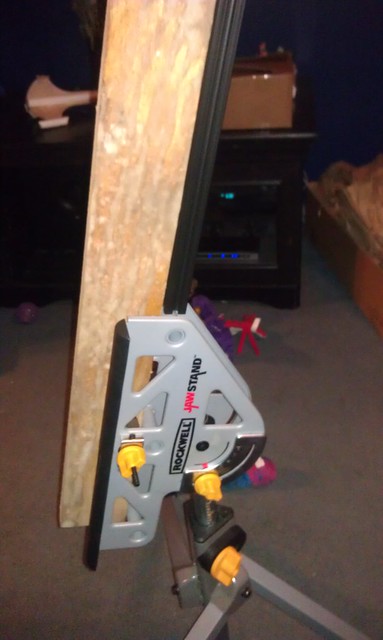BeerorKid
Well-Known Member
- Joined
- Dec 12, 2012
- Messages
- 1,148
- Reaction score
- 36
I am still a noob in most ways. My question is simply this, but I am not sure how to word it right.
If you have some wind and angle your launch rod a bit to get it to land near you, should the rocket be placed under the angle or on top or it?
[video=youtube;A34em4HOXLA]https://www.youtube.com/watch?v=A34em4HOXLA[/video]
So in the above vid I would say that the rocket is on top of the angle that is leaning to the left. I am guessing that is why the rocket did not launch, but later found a bit of glue on the lug. Rocket still slid down the rod with ease though. I figured the lug binded from wanting to go up but tweaked against the lug holding it there
The reason I am asking is because I picked up a rail and the Rockwell Jaw Stand showed up today and I am working on making a rail holder that I can clamp down in the stand.

It seems most folk attach the rail on the outside part of the wood or device that is in the clamps. As in the left side of the pic.
I was thinking that if I put the rail on the inside (right side of the pic) and closer to the center of the stand it would make it more sturdy. But my thinking is that all of my rockets would be on the bottom of the angle if I do angle it.
Of course I will still work on a blast shield and cut that piece of wood down to proper length, so I am not worried about gasses harming the stand. Just wondering if any of you have thoughts on launching under or over the angle. I also agree with some other thread I cannot find now that any angle usually results in more trouble than it is worth, but figure I might do a few degrees of tilt on slightly windy days in the future.
Any tips on why my rail should be on the outside welcome as well.
If you have some wind and angle your launch rod a bit to get it to land near you, should the rocket be placed under the angle or on top or it?
[video=youtube;A34em4HOXLA]https://www.youtube.com/watch?v=A34em4HOXLA[/video]
So in the above vid I would say that the rocket is on top of the angle that is leaning to the left. I am guessing that is why the rocket did not launch, but later found a bit of glue on the lug. Rocket still slid down the rod with ease though. I figured the lug binded from wanting to go up but tweaked against the lug holding it there
The reason I am asking is because I picked up a rail and the Rockwell Jaw Stand showed up today and I am working on making a rail holder that I can clamp down in the stand.

It seems most folk attach the rail on the outside part of the wood or device that is in the clamps. As in the left side of the pic.
I was thinking that if I put the rail on the inside (right side of the pic) and closer to the center of the stand it would make it more sturdy. But my thinking is that all of my rockets would be on the bottom of the angle if I do angle it.
Of course I will still work on a blast shield and cut that piece of wood down to proper length, so I am not worried about gasses harming the stand. Just wondering if any of you have thoughts on launching under or over the angle. I also agree with some other thread I cannot find now that any angle usually results in more trouble than it is worth, but figure I might do a few degrees of tilt on slightly windy days in the future.
Any tips on why my rail should be on the outside welcome as well.
Last edited:








